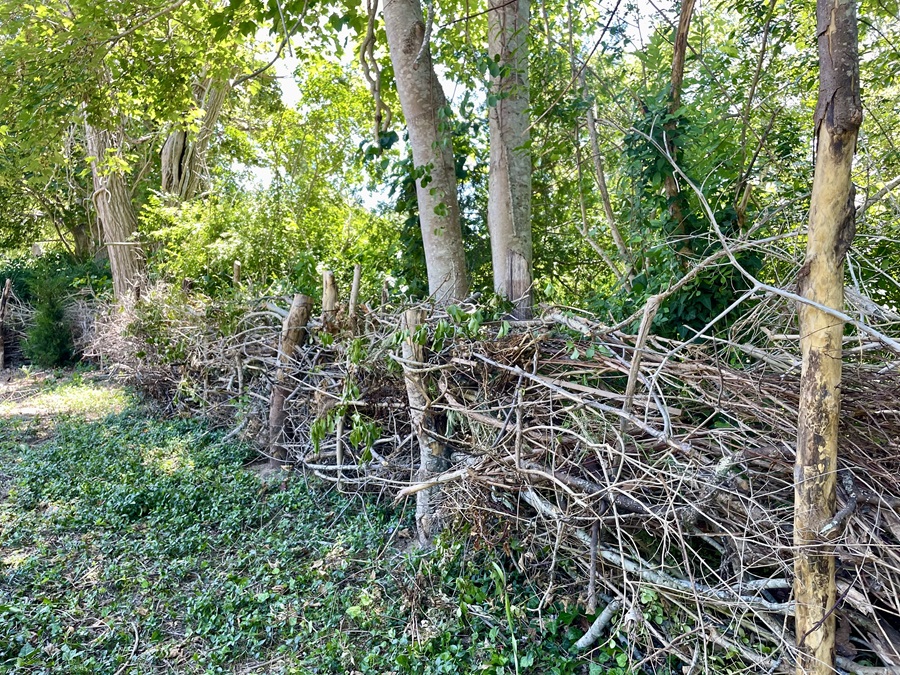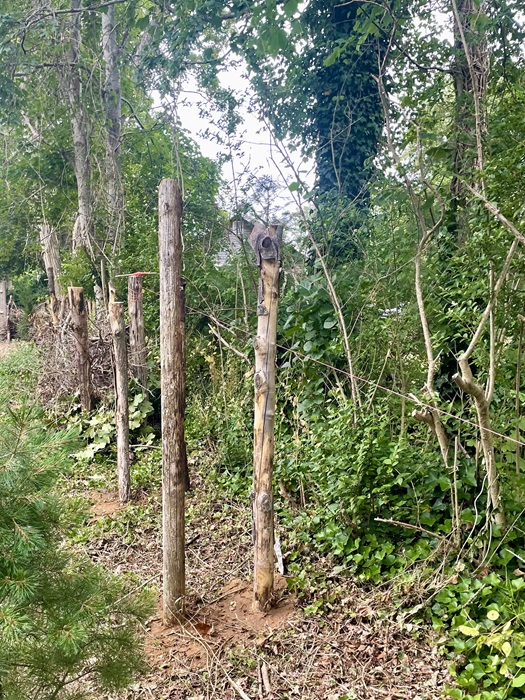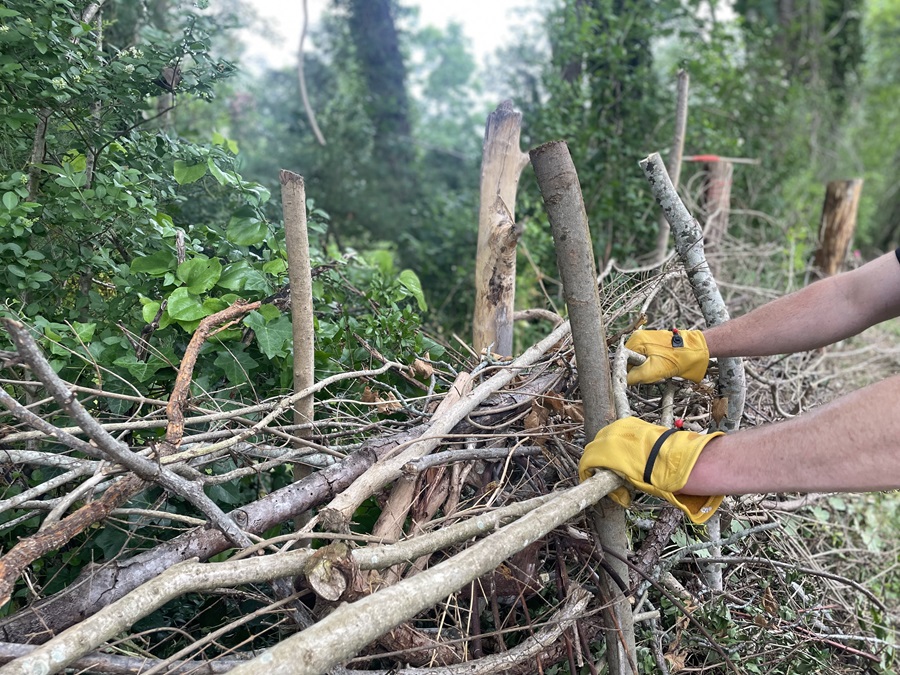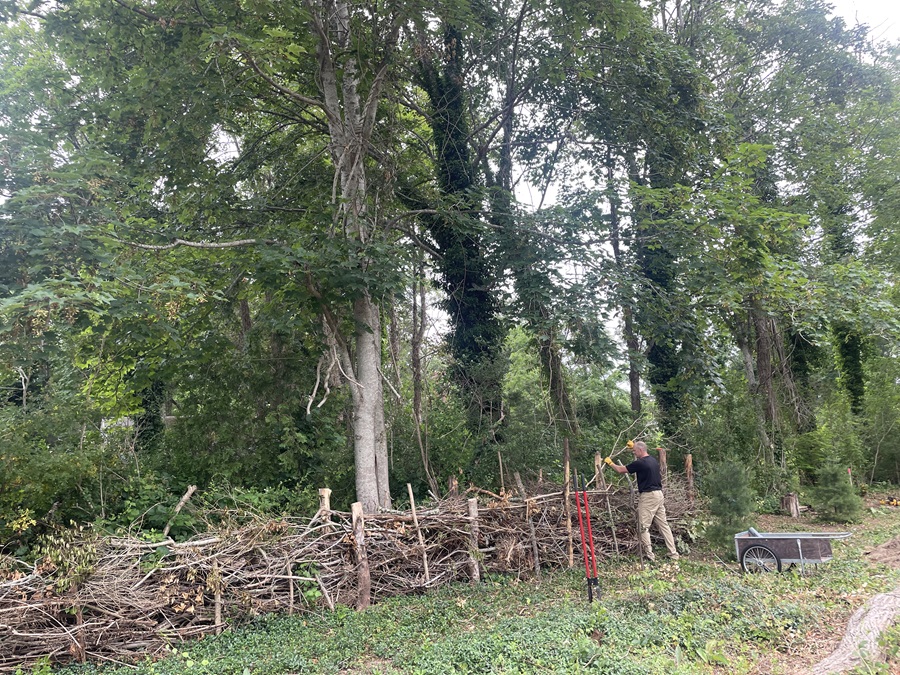We never put much effort into the woods at the back of our property. Hurricane Bob took out most of the locust trees, then sycamore maples, honeysuckle, and runaway privet moved in and multiplied. A more aggressive coterie of invasive plants came next: multiflora rose, bittersweet vines, and English ivy began to take over.
The takeover of the area out back — that’s the only name we ever gave that forgotten part of the yard — was gradual until it wasn’t. The bittersweet vine thrust upward, dragging tree limbs nearly to the ground. The ivy grew to a knee-deep thicket. And the privet filled in any space that the vines left unclaimed. So, in the summer of 2023, my husband and I began to claw back sections by hand, digging up plants and roots with metal rakes and spades. It was backbreaking work and achingly slow.

Once we moved past the immediate area behind the house, we knew we needed help and hired Fred Rich, who owns an excavating business, to bring in heavy machinery to tear out the brush and take down many of the non-native trees. We asked him to leave us two massive piles of tree trunks, limbs, and branches that remained when he was done. We knew we would use it in some capacity, either as firewood, natural edging, or wood chips.
That winter, we identified what we wanted to backfill out back. The list was long: red cedar, tupelo, white oak, sassafras, bayberry, winterberry, summersweet, inkberry, buttonbush, spicebush, beach plum, elderberry, sweetfern. We placed an order with Nasami Farm Nursery in Whately, which grows native plants from seeds sustainably harvested in New England and is part of the Native Plant Trust.
We rented a box truck and headed up to the trust’s Framingham location to pick up the order, making time to tour their Garden in the Woods with its more than 1,000 species of native plants. There we saw an unusual display — bundles of fallen logs snaking back and forth like an undulating river of wood. Called “the hidden valley,” it was designed by landscape architect W. Gary Smith in 2007 as part of an exhibit for the garden’s 75th anniversary.

We decided to use our brush pile to make something similar. Over the next year, we learned a lot about what we now know is called a dead hedge.
These barriers made of woven branches and foliage date back to before the Bronze Age, according to Hugh Barker, author of Hedge Britannia. It is easy to see the appeal of this full circle approach to demarcating land using material cleared from it. And modern gardeners appreciate the ways the organic structures create habitat for wildlife and insects.
Much like our plant list, our vision for the dead hedge was outsize: it would be two feet wide and roughly 175 feet long. We started by sorting the piles, separating small logs and thick limbs that would make good posts from the sticks that would be better as fill. Then, we ran a string line to ensure the dead hedge followed a somewhat straight path.

The way you approach creating a dead hedge depends on the area you are defining, the material you have available, and the look you are after. For a more traditional fence-like hedge, you can install a single line of posts and tightly weave long, thin limbs into rails. Or you can tidily stack branches horizontally; this version usually features a double row of closely set posts to achieve a packed-in look. Others eschew posts entirely and pile material vertically without any supports.
After looking at different examples online, we decided to go with a double row of posts and allow the brush fill to settle somewhat naturally without manipulating it into a fixed weave. We installed pairs of seven-foot posts at six-foot intervals, set two feet into the ground, one-and-a-half feet apart. Each post is about four to six inches in diameter. At the midpoint between each set of posts, we added another set of what we call “stakes” — smaller limbs that we slammed in with a handheld post driver.

Our design was informed by both material and labor. By staggering the posts with the stakes, we were able to make use of solid enough branches that wouldn’t have provided enough support on their own. Also, we had to dig only 58 holes instead of 116. A dead hedge of this scale is an arduous undertaking, but they can certainly be made on a smaller scale.
Now, more than halfway through the project, we are already close to the bottom of our brush pile. The plan is to continue to build and fill the hedge with yard debris over time.
It’s already a vast improvement over tangled ivy and bittersweet. Plenty of birds are exploring the addition out back. We have seen grackles and cardinals perched atop the posts as well as wrens and chickadees exploring the bramble. The dead hedge comes alive at dusk when the fireflies blink their special patterns in search of mates.



